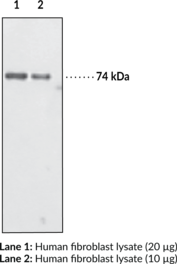Description
Stimulator of interferon genes (STING) is a component of the innate immune response that binds to cyclic dinucleotides (CDNs), which are bacterial second messengers, leading to activation of NF-κB and transcription of immunomodulatory genes, including type I interferon (IFN).{22400,22401,24611,24607} The C-terminal region of STING binds to CDNs, such as cyclic di-GMP (c-di-GMP; Item No. 17144) in the cytoplasm at a ratio of two STING molecules to one c-di-GMP.{24607,39991} Mutations in the C-terminal region modify the activity of STING in a variety of ways.{24607} Certain mutations, such as the mutation found in the Goldenticket mouse strain, I199N, prevent STING from binding to CDNs and from inducing an IFN response. However, other mutations in the C-terminal region allow STING to bind c-di-GMP but not induce IFN, hyperinduce IFN without binding c-di-GMP, or induce IFN only when overexpressed and without binding c-di-GMP. STING inhibition has the potential to be beneficial for the treatment of autoimmune diseases that are associated with uncontrolled activation of the STING pathway, while activation of STING can lead to an adaptive immune response that reduces tumor growth in animal models.{39992,41598,38806,39993} Cayman’s STING (C-Term) Monoclonal Antibody (Clone 1B10) can be used for ELISA, IHC, and WB applications. The antibody recognizes the C-terminal region of STING at 42 kDa from human samples.
Synonyms: Endoplasmic Reticulum Interferon Stimulator|ERIS|Mediator of IRF3 Activation|MITA|MPYS|Stimulator of Interferon Genes|TMEM173|Transmembrane Protein 173
Immunogen: Synthetic peptide from the C-terminus (AA 351-379) of human STING protein
Formulation: 100 µg of protein G-purified monoclonal antibody
Isotype: IgG1
Applications: ELISA, IHC, and WB
Origin:
Stability: 365 days
Application|ELISA||Application|Immunohistochemistry||Application|Western Blot||Product Type|Antibodies|Monoclonal Antibodies||Research Area|Cancer||Research Area|Epigenetics, Transcription, & Translation|Transcription Factors||Research Area|Immunology & Inflammation|Autoimmunity||Research Area|Immunology & Inflammation|Innate Immunity|Pattern Recognition||Research Area|Immunology & Inflammation|Innate Immunity|STING||Research Area|Infectious Disease



